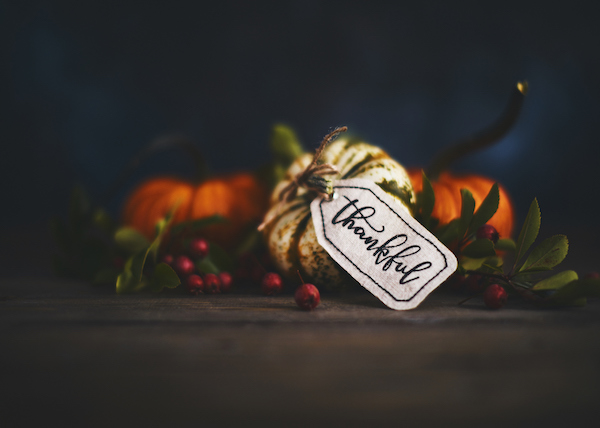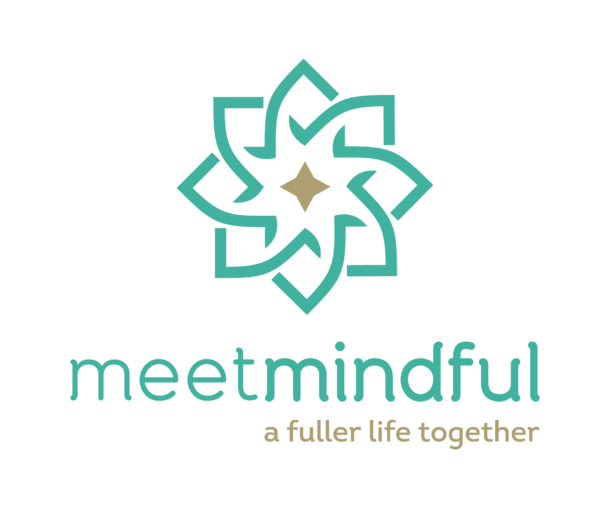When our hearts are full, practicing gratitude comes naturally. Knowing how to practice gratitude when we’re just not feeling it takes a little more work.
It’s the most wonderful time of the year! So why doesn’t it feel like it?
Ever had a holiday season where you were confronted with your own unhappiness or discontent, along with feelings of self-judgment for not feeling particularly grateful for what you have?
My mind flashes back to Thanksgiving five years ago. I had ended a dating relationship about two weeks prior, and in addition to feeling all the normal feelings that come with a break-up, my sense of loneliness felt heightened due to my lack of a special someone with whom to share the upcoming holiday season. Also, my parents had sold my childhood home and were temporarily living in an apartment with borrowed furniture and minimal decorations, making the whole holiday experience feel surreal and a bit depressing. I spent time throughout the day, holing up in the only bathroom in their apartment to allow myself privacy to shed some tears—very aware that I had no good reason to not be grateful when I was surrounded by my loved ones, with all of my basic needs met. I found myself wondering: how do I experience both grief and gratitude simultaneously? Is it possible to do without feeling like Dr. Jekyll and Mr. Hyde?
Dr. Robert Emmons is one of the world’s leading scientific researchers on the subject of gratitude. He defines gratitude as an affirmation of goodness that comes from a source outside of one’s self. He writes that practicing gratitude does not mean we ignore complaints, burdens, or the fact that our lives are not perfect. Instead, practicing gratitude leads us to identify the goodness in our lives, as well as acknowledge the big and small gifts that come from other people and/or a Higher Power to help us achieve this goodness in our lives.
I recently read an article about the very first Thanksgiving, celebrated by the Pilgrims and Indians. In September 1620, the Mayflower and its 102 passengers arrived at Cape Cod, far north of their intended destination. They had survived 66 brutal days at sea and many of the passengers lived aboard the ship throughout the first winter, suffering from exposure, scurvy, and other diseases. In March of 1621, the passengers who had survived the winter moved ashore, where they received a visit from an Abenaki Indian—who greeted them in English—and later returned with Squanto, an Indian who had previously been captured by an English sea captain, sold into slavery in London, and eventually returned home on an exploratory expedition. Squanto taught the Pilgrims how to farm, fish, and avoid poisonous plants in this new land. He also helped settlers form an alliance with a local Native American tribe. In November of 1621, after the Pilgrims’ first successful corn harvest, Governor William Bradford organized a celebratory feast, inviting a group of Native American allies to participate in a three-day festival.
While I’ve known this story most of my life, I was struck by a couple of specific details. First, the Pilgrims did not land where they intended to land. Yet, because of where they landed, they connected with Native Americans, who just happened to speak English! Clearly, a Higher Power was at work in granting these poor Pilgrims this gift. Second, not only did these Native Americans speak English, they saved these Pilgrims’ lives by teaching them about the land and how to farm and fish, when they very well could have taken revenge for the way they had been treated by English settlers in the past. These Native Americans gave the Pilgrims the gift of survival and self-sufficiency, as well as mercy and grace.
Is it possible to practice gratitude in the midst of pain, when we don’t have heroes like the Native Americans to rescue us or offer a respite from our suffering?
Dr. Emmons acknowledges that practicing gratitude can be difficult, and that it’s a choice, not a feeling. He writes: “When people are grateful, they aren’t necessarily free of negative emotions…practicing gratitude magnifies positive feelings more than it reduces negative feelings.” Practicing gratitude does not replace difficult thoughts, feelings, or circumstances with warm, fuzzy feelings. If that were the case, we probably wouldn’t need to pause and practice it—we’d just do it automatically!
Dr. Emmons believes that practicing gratitude in the midst of suffering is vital to helping us get through these difficult times. He writes that during times of adversity, “gratitude helps us see the big picture and not feel overwhelmed by the setbacks we’re facing in the moment.” He also writes that practicing gratitude can motivate us to tackle the challenges we face. His observations come from a study he conducted, where he asked people suffering from severe neuromuscular disorders to keep a gratitude journal over two weeks. Not only did they find reasons to be grateful, they also experienced significantly more positive emotions than a similar group that didn’t keep a gratitude journal.
So, what are some practical ways in which we can practice gratitude without disregarding our pain? First, it’s important to acknowledge our difficult thoughts and feelings without judgment, even during this time of year, where we are especially called to be grateful. As Dr. Emmons puts it, denying that life has its share of disappointments, frustrations, losses, hurts, etc. is “unrealistic and untenable.” We can acknowledge our pain, as well as those things that we are thankful for. We can further explore our pain and find places where we can reframe. Dr. Emmons cites Mother Theresa as an example, in that she said she was grateful to the sick and dying who she served in the slums because they “enabled her to grow and deepen her spirituality.” She practiced gratitude for what she could give, as opposed to what she received. We can also allow our trials and suffering to show us what not to take for granted, what we value, as well as how these trials are shaping us into who we are today.
Second, we can allow feelings of both grief and gratitude to coexist inside of us. According to Dr. Emmons, when we allow for our feelings of grief to exist, rather than avoid them, we are able to remember them, to remember where we are now, and that we are alive, making it through this dark time, and making our way out of the dark.
Third, we can take specific action steps to cultivate our practice of gratitude. Dr. Emmons recommends listing what you’re grateful for, as it intentionally and consciously focuses our attention on increasing grateful thinking and helps guard against taking things for granted. We can also use our five senses of touch, taste, sight, smell, and hearing to cultivate gratitude, as these help us appreciate what it means to be human and alive. Dr. Emmons writes: “Seen through the lens of gratitude, the human body is not only a miraculous construction, but also a gift.” Visual reminders to practice gratitude, like a post-it note on the bathroom mirror, a reminder on your phone, or even other people can be helpful, since forgetfulness and a lack of mindful awareness are two common barriers to gratefulness, according to Dr. Emmons.
It’s worth noting that practicing gratitude may serve as an antidote—or at the very least, an anesthetic—to pain and suffering. For example, Dr. Emmons found in his research that practicing gratitude led to physical, psychological, and social benefits, including stronger immune systems, higher levels of positive emotions, and fewer feelings of loneliness and isolation, just to name a few!
“One of the reasons gratitude makes us happier is that it forces us to abandon a belief that may accompany severe depression—that the world is devoid of goodness, love, and kindness, and is nothing but randomness and cruelty,” writes Dr. Emmons. Despite my grief, pain, and disappointment at Thanksgiving five years ago, I was able to experience the love and kindness of my family as we spent the day together. And we have the reminder of the Native Americans’ goodness, love, and kindness to the Pilgrims, who had endured the randomness and cruelty of a long voyage, religious persecution, famine, and disease. Says Dr. Emmons: “By feeling grateful, we are acknowledging that someone, somewhere, is being kind to us. And therefore, we can see not just that we are worthy of kindness, but that kindness indeed exists in the world and, therefore, that life may be worth living.”
May we all have eyes to see the kindness in the world and the many gifts we’ve been given this holiday season and in the coming year!
References:
- Emmons, R. (2013). Five myths about gratitude. Greater Good Magazine. Retrieved from https://greatergood.berkeley.edu/article/item/five_myths_about_gratitude.
- Emmons, R. (2013). How gratitude can help you through hard times. Greater Good Magazine. Retrieved from https://greatergood.berkeley.edu/article/item/how_gratitude_can_help_you_through_hard_times
- Emmons, R. (2007). Pay it forward. Greater Good Magazine. Retrieved from https://greatergood.berkeley.edu/article/item/pay_it_forward
- Emmons, R. (2010). Why gratitude is good. Greater Good Magazine. Retrieved from https://greatergood.berkeley.edu/article/item/why_gratitude_is_good
- Emmons, R. (2010). 10 ways to become more grateful. Greater Good Magazine. Retrieved from https://greatergood.berkeley.edu/article/item/ten_ways_to_become_more_grateful1
- Thanksgiving 2018. (2009, October 27). Retrieved from https://www.history.com/topics/thanksgiving/history-of-thanksgiving
About the Author
Julie Williamson is the Founder and Therapist at Abundant Life Counseling St. Louis LLC. She is a Licensed Professional Counselor, National Certified Counselor, and Registered Play Therapist. She enjoys working with women facing the challenges of anxiety, depression, and various relational issues, including developing healthy dating relationships. You can learn more about Julie at abundantlifecounselingstl.com


